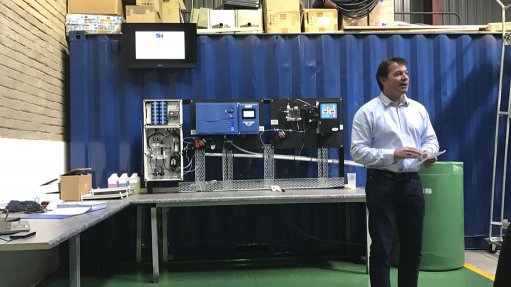
MARK ROWAND The Smart Low Energy Analyser will provide consistently safe water, operation efficiently, low energy demands and cut costs
Environmental consultancy SI Analytics, a division of JSE-listed technology solutions provider EOH, has launched the new Smart Low Energy Analyser (Lea), a self-powered and multiparameter water- quality analyser.
The analyser is equipped with sensors that collect and transmit data to be used in predictive analysis systems in smart water networks.
It is an intelligent multitasking system that enhances timed operations to reduce power consumption. It provides multiparametric measurements of free chlorine or total chlorine, pH, turbidity, conductivity, flow, temperature, reduction potential, oxidation and reduction potential, as well as water pressure that give the full scope to understand the quality of the water.
The analyser is manufactured by Israel-based water analytics solutions provider Blue I Technologies and is distributed locally by SI Analytics.
“The Smart Lea will provide consistently safe water, operation efficiently, low energy demands and cut costs,” says SI Analytics director Mark Rowand.
The pressure on water resources is increasing rapidly, with the World Water Assessment Programme reporting that two-million tons of human-related waste a day is disposed into water courses and, in addition, over the past few years, the increase in fertilisers used for food production has increased global nitrogen pollution in rivers by up to 20%.
Rowand argues that, as land-based activities can have a significant impact on water systems, it is critical to realise how these activities affect waterbodies above and below ground.
“As more online data is collected, the handling and interpreting of this information for management procedures is becoming the next challenge in water-quality monitoring,” Rowand points out, suggesting that the Lea analyser could be a solution to this challenge.
Blue I Technologies sales and business development VP Niv Morag agrees, highlighting that, as water distribution networks are steadily entering the age of smart technology and communication, municipalities and urban water management are seeking to implement the Internet of Things for intelligent water distribution systems.
“The network’s goals are best achieved by ensuring meticulous water-quality monitoring at many key locations along the extensive distribution network. However, even in urban places where power supply and communication are within reach, the main barrier of real-time, online water quality monitoring is the high cost of the monitoring station itself,” he explains.
The Smart Lea eliminates the need to build a full monitoring station, owing to its in-house power supply and communication, subsequently reducing the civil costs and infrastructure needed to operate a quality monitoring station significantly, Morag highlights.
Each sensor in the analyser is designed to operate with a low electricity current, while a smart ‘sleep mode’ between measurements preserves probe life, saves energy and allows for an immediate response when awakened for measurement, Morag explains.
Measurement data and alarms are logged locally and also transmitted through global system for mobile communication and/or general packet radio service.